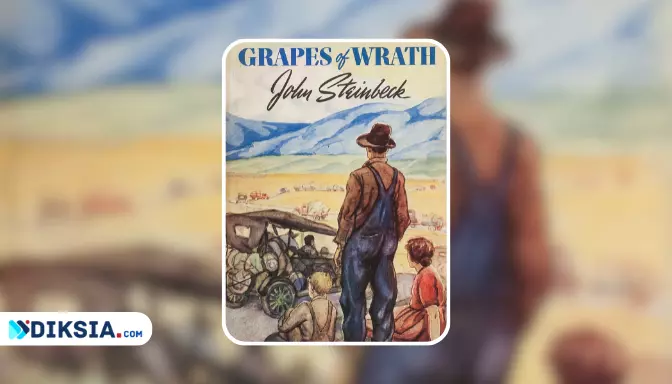Diksia.com - The Grapes of Wrath is a novel by John Steinbeck that was published in 1939 and won the Pulitzer Prize for fiction. It is widely regarded as one of the greatest American novels of the 20th century, and a masterpiece of social realism.
The novel tells the story of the Joad family, a poor farming family from Oklahoma, who are forced to leave their home and migrate to California during the Great Depression and the Dust Bowl.
Along the way, they face many hardships and injustices, but also encounter kindness and solidarity from other migrants and activists. The novel explores themes such as human dignity, social justice, family, religion, and the American dream.
The Grapes of Wrath is not only a historical document, but also a timeless and universal tale of survival and hope. It is a novel that speaks to the human condition, and to the conflicts between the powerful and the powerless, the haves and the have-nots, the oppressors and the oppressed.
It is a novel that challenges us to question our values, our actions, and our responsibilities as citizens and as human beings. It is a novel that can inspire us to fight for a better world.
In this article, I will provide a detailed review of The Grapes of Wrath, covering its book details, recommended audience, overview, plot summary, characters and character development, theme and message, writing style, pros and cons, comparison to other works, and where to read the book. I hope you will find this review helpful and informative.
Book Details
- Title: The Grapes of Wrath
- Author: John Steinbeck
- Genres: Classics, Fiction, Historical Fiction, Literature
- Chapters: 30
- Language: English
- Publisher: Viking Press
- Publication date: April 14, 1939
- Rating: 4.00 out of 5 stars (based on Goodreads ratings)
- Awards: Pulitzer Prize for Novel (1940), National Book Award for Fiction (1939), Nobel Prize in Literature (1962)
Recommended Audience
The Grapes of Wrath is a novel that can be enjoyed by readers of different ages and backgrounds. However, it is not an easy or light read.
It is a long and complex novel that deals with serious and mature topics such as poverty, violence, oppression, exploitation, death, hunger, and injustice.
It also contains some graphic scenes and strong language that may not be suitable for younger or sensitive readers. Therefore, I would recommend this novel to readers who are:
- At least 16 years old or older
- Interested in American history, especially the Great Depression and the Dust Bowl
- Interested in social issues and human rights
- Interested in realistic and naturalistic fiction
- Willing to invest time and attention to appreciate the depth and richness of the novel
Overview
The Grapes of Wrath is divided into 30 chapters that alternate between two types: narrative chapters that follow the story of the Joad family; and intercalary chapters that provide broader perspectives on the social, economic, political, and environmental conditions of the time.
The novel is set in the 1930s during the Great Depression and the Dust Bowl, a period of severe drought and dust storms that affected millions of farmers in the Great Plains region of the United States. Many farmers lost their land due to foreclosure or erosion, and were forced to migrate westward in search of work and a better life.
However, they faced hostility and exploitation from the local residents and authorities in California, who saw them as unwanted intruders and cheap labor.
The novel begins with Tom Joad returning to his family farm in Oklahoma after serving four years in prison for manslaughter. He meets Jim Casy, a former preacher who has lost his faith but still believes in helping people.
Together they find out that Tom’s family has been evicted from their land by a bank agent who represents large landowners who want to consolidate their properties.
They join Tom’s family at his uncle’s farm where they prepare to leave for California with their truck loaded with their belongings.
Along with Tom’s parents (Pa and Ma), his grandparents (Grampa and Granma), his siblings (Noah, Al, Rose of Sharon, Ruthie, Winfield), his brother-in-law (Connie), his uncle (Uncle John), his friend (Casy), they form part of a larger group of migrants known as “Okies”.
The journey to California is long and arduous. They encounter many difficulties such as mechanical breakdowns, lack of food and water, highway patrolmen, scams, illnesses, deaths, and violence. They also meet other migrants who share their stories and their hopes.
They learn about the harsh realities of California, where there is not enough work or land for everyone, and where they are discriminated and oppressed by the wealthy landowners and their agents.
They witness the contrast between the abundance and waste of the rich and the hunger and misery of the poor. They also witness the emergence of labor unions and strikes that challenge the status quo and demand fair wages and treatment.
The novel ends with a climactic scene in which Tom kills a deputy who has shot Casy during a strike. He escapes and hides in the mountains, where he tells his mother that he will continue Casy’s work of fighting for justice and freedom.
He leaves his family with a promise to be with them wherever they go. The family moves on to a new camp, where they find shelter in a boxcar with other migrants. There, Rose of Sharon gives birth to a stillborn baby, which they bury in the mud.
The novel closes with a symbolic scene in which Rose of Sharon breastfeeds a starving man in a barn, showing an act of compassion and humanity in the midst of despair and hopelessness.
Plot Summary
The following is a brief summary of the main events that happen in each chapter of the novel:
Chapter 1
The novel opens with a description of the Dust Bowl in Oklahoma, where the crops are destroyed by drought and dust storms, and the farmers are desperate and hopeless.
Chapter 2
Tom Joad hitchhikes a ride with a truck driver who is curious about his past. Tom reveals that he has just been released from prison after serving four years for killing a man in self-defense.
Chapter 3
A turtle crosses the road, symbolizing the struggle and resilience of nature and life. Tom picks up the turtle and puts it in his coat.
Chapter 4
Tom meets Jim Casy, a former preacher who has given up preaching because he no longer believes in sin or grace. Casy tells Tom that he has been wandering around, trying to find his purpose in life. They decide to go together to Tom’s family farm.
Chapter 5
A bank agent arrives at a farm to evict the tenants who have failed to pay their mortgages. He tells them that they have to leave because the land belongs to the bank, which is controlled by larger interests. The tenants are angry and helpless, and some threaten to resist or fight back.
Chapter 6
Tom and Casy reach Tom’s family farm, only to find it deserted and ruined. They meet Muley Graves, an old neighbor who has refused to leave his land. Muley tells them that Tom’s family has been evicted and has gone to stay with his uncle John nearby. He also tells them that many families have left for California, where there are supposed to be jobs and opportunities.
Chapter 7
A car salesman sells used cars and trucks to the migrants who want to go to California. He uses various tricks and lies to cheat them and make more money.
Chapter 8
Tom and Casy join Tom’s family at his uncle John’s farm, where they are preparing to leave for California. They meet Tom’s parents (Pa and Ma), his grandparents (Grampa and Granma), his siblings (Noah, Al, Rose of Sharon, Ruthie, Winfield), his brother-in-law (Connie), and his uncle (Uncle John). They load their truck with their belongings and their animals. Grampa refuses to go, but they drug him with soothing syrup and take him along.
Chapter 9
The migrants sell or burn their possessions that they cannot take with them. They feel sad and bitter about leaving their homes and memories behind.
Chapter 10
The Joads leave for California with their truck, which is old and overloaded. They join a highway full of other migrants like them. They stop at a gas station, where they are treated rudely by the owner who dislikes Okies.
Chapter 11
The deserted farms are vandalized by tractors that plow through them, destroying everything in their path. The houses are left empty and decaying, haunted by the ghosts of the past.
Chapter 12
The migrants travel westward along Route 66, which is described as “the mother road” that connects them to their destination. They face many hardships such as heat, dust, hunger, thirst, and fatigue. They also encounter kindness from other travelers who share their food or help them fix their cars.
Chapter 13
The Joads stop at a roadside camp where they meet Ivy and Sairy Wilson, a couple from Kansas whose car has broken down. They help each other by sharing their tents and their food. Grampa becomes ill and dies at the camp. The Wilsons agree to join the Joads on their journey.
Chapter 14
The narrator reflects on how the migrants are changing from individual families to a collective group of people who share a common experience and a common goal. He argues that this change is necessary for their survival and their resistance against the forces that oppress them.
Chapter 15
The narrator describes the contrast between the roadside restaurants and the migrants who stop there. The restaurant owners and workers are suspicious and contemptuous of the migrants, who are hungry and poor. However, some of them also feel pity and sympathy for them, and sometimes give them food or candy.
Chapter 16
The Joads and the Wilsons continue their journey along Route 66. They cross the border into New Mexico, where they meet a man who tells them that there is no work in California, and that the handbills advertising jobs are lies.
He also tells them that the Californians hate the Okies and treat them badly. The Joads are worried but they decide to keep going. They reach the border of Arizona, where they are inspected by a border guard who lets them pass.
Chapter 17
The narrator describes how the migrants form camps along the road, where they create a sense of community and order. They establish rules and norms to regulate their behavior and to protect themselves from trouble. They also have fun and entertainment by singing, dancing, telling stories, and playing games.
Chapter 18
The Joads and the Wilsons cross the desert at night, hoping to avoid the heat and the police. Sairy Wilson is sick and cannot go on, so they decide to stay behind with her husband. The Joads give them some money and promise to pray for them.
The Joads make it across the desert and reach the border of California, where they are stopped by a hostile inspection officer who insults them and searches their car.
They enter California and camp at a river, where they meet a ragged man who tells them that his son died of starvation in California, and that there is no work or hope there. He warns them to turn back before it is too late.
Chapter 19
The narrator gives a historical account of how California was taken over by white settlers who drove away the Native Americans and the Mexicans from their land. He explains how the landowners became rich and powerful by exploiting the land and the workers, and how they tried to preserve their wealth and status by controlling the laws and the police.
He contrasts their greed and wastefulness with the needs and desires of the migrants, who only want a little piece of land to live and work on.
Chapter 20
The Joads leave the river camp and drive towards a town called Bakersfield, where they hope to find work. They stop at a Hooverville, a shanty town where many migrants live in squalid conditions. They meet Floyd Knowles, a young man who tells them that there is no work in the area, and that the handbills are fake.
He says that the contractors use them to lure more workers than they need, so that they can lower the wages and break up strikes. A contractor arrives at the camp with a deputy sheriff, offering work at a peach orchard. Floyd asks to see his license and his wage rate, but the contractor refuses to show them.
The deputy tries to arrest Floyd on a false charge, but Floyd punches him and runs away. Tom trips the deputy and Casy knocks him out with a pick handle. Casy tells Tom to hide in the camp and takes the blame for the fight. He is taken away by another deputy who arrives with reinforcements.
Chapter 21
The narrator describes how the migrants are hated and feared by the Californians, who see them as a threat to their way of life. He shows how the Californians use various methods to keep them down, such as spreading lies about them, burning their camps, paying low wages, charging high prices, and denying them education and health care.
He also shows how some of the migrants start to fight back, organizing unions, going on strikes, and demanding their rights.
Chapter 22
Tom sneaks out of the Hooverville with his family after dark. They drive away from Bakersfield and look for another place to stay. They come across Weedpatch Camp, a government camp that is run by a committee of migrants.
They are welcomed by Mr. Thomas, the camp manager, who tells them that there is no work at the moment, but there might be some cotton picking soon. He also tells them that they have to follow some rules in order to stay in the camp, such as keeping it clean, respecting others, and participating in camp activities.
The Joads are impressed by the facilities and the services of the camp, such as the toilets, the showers, the kitchen, the library, the nursery, and the entertainment hall. They feel safe and comfortable in the camp, where they are treated with dignity and respect.
Chapter 23
The narrator describes how the migrants cope with their misery and boredom by creating music and art. He shows how they use various instruments, such as guitars, harmonicas, fiddles, and spoons, to play songs that express their emotions and their stories. He also shows how they use other forms of art, such as storytelling, dancing, painting, and carving, to enrich their lives and their culture.
Chapter 24
The Joads settle in Weedpatch Camp, where they make friends with other migrants and participate in camp activities. They attend a dance at the entertainment hall, where they have fun and relax.
However, they also face some trouble from a group of intruders who are sent by the Farmers’ Association, a group of landowners who are opposed to the government camps. The intruders try to start a fight in order to give an excuse for the police to raid the camp, but they are foiled by the camp guards and the camp committee.
Chapter 25
The narrator describes how the land of California produces abundant and beautiful crops, but also how these crops are wasted and destroyed by the landowners who control the market and the prices.
He shows how the landowners use various methods to prevent the crops from reaching the people who need them, such as dumping them into rivers, burning them, spraying them with poison, or letting them rot. He also shows how this waste and destruction leads to hunger and death among the migrants and the poor.
Chapter 26
The Joads leave Weedpatch Camp after staying there for a month, because they need to find work in order to buy food and clothes. They drive around looking for work, but they find that most places are overcrowded with workers or offer very low wages.
They finally find work at a peach orchard, where they are paid five cents per box of peaches. They do not know that this orchard is the site of a strike led by Casy and his followers, who are protesting against a wage cut. They also do not know that they are scabs, workers who replace strikers.
They enter the orchard through a guarded gate, where they are given tents to live in. They feel uneasy about the situation, but they decide to take the work anyway because they are desperate.
Chapter 27
The narrator describes how the migrants pick cotton as their last chance to make some money before winter. He shows how they work hard and fast, trying to fill as many sacks as possible.
He also shows how they compete with each other for work, and how they suffer from injuries and infections caused by the cotton bolls. He also shows how some of them manage to save some money or buy some luxuries, such as candy or tobacco.
Chapter 28
Tom sneaks out of the peach orchard at night to look for Casy and his strikers. He finds them hiding in a stream bed near the orchard. He talks to Casy, who tells him that he has been organizing workers to demand fair wages and conditions.
He also tells him that he has been inspired by Tom’s words about being part of something bigger than himself. He says that he has realized that all people are holy and that they have a spirit that connects them to each other and to God.
He says that he is willing to die for this cause if necessary. As they are talking, they are attacked by a group of men who have been sent by the landowners to break up the strike.
One of them hits Casy with a pick handle on his head, killing him. Tom grabs the pick handle and hits the man back on his face, killing him. He escapes back to his family’s tent with a deep cut on his cheek.
Chapter 29
The narrator describes how a heavy rain falls on California, causing floods and mudslides that ruin the crops and damage the roads and bridges. He shows how this rain affects the migrants, who have nowhere to go or stay.
He shows how some of them drown or die of pneumonia or starvation. He also shows how some of them lose hope or go crazy or turn violent. He also shows how some of them cling to their faith or their dreams or their love for each other.
Chapter 30
The Joads leave the peach orchard after finding out that they have been scabs and that Tom has killed a man. They drive away from the area and look for another place to work. They find a cotton field, where they are hired to pick cotton. They are given a boxcar to live in, which they share with another family, the Wainwrights.
There, Rose of Sharon goes into labor and gives birth to a stillborn baby, which they bury in the mud. Tom tells his family that he has to leave them because he is wanted by the police and he does not want to endanger them. He says that he will continue Casy’s work of fighting for justice and freedom.
He says that he will be with them wherever they go, in their hearts and minds. He leaves his family with a promise to write to them if he can. The family moves on to a new camp, where they are told that the water is rising and they have to leave soon.
They try to drive away, but their car breaks down and they are stuck in the flood. They find shelter in a barn, where they find a starving man and his son. Rose of Sharon offers to breastfeed the man with her milk, showing an act of compassion and humanity in the midst of despair and hopelessness.
Characters and Character Development
The following is a list of the main characters in the novel and their development throughout the story:
- Tom Joad: The protagonist of the novel, a young man who returns to his family after serving four years in prison for killing a man in self-defense. He is strong, brave, loyal, and intelligent, but also impulsive, rebellious, and violent. He loves his family and tries to protect them from harm. He is influenced by Casy’s teachings and becomes more aware of the social and political issues that affect the migrants. He kills a deputy who has killed Casy and becomes a fugitive. He decides to continue Casy’s work of fighting for justice and freedom.
- Ma Joad: The matriarch of the family, a middle-aged woman who is strong, resilient, practical, and compassionate. She holds the family together and takes care of their needs. She is determined to keep her family alive and united. She is supportive of Tom and his decisions. She is proud of her dignity and her spirit.
- Pa Joad: The patriarch of the family, an old man who is weak, passive, insecure, and depressed. He loses his authority and his confidence as he loses his land and his livelihood. He feels guilty and ashamed of his inability to provide for his family. He follows Ma’s lead and tries to help his family as much as he can.
- Jim Casy: A former preacher who has given up preaching because he no longer believes in sin or grace. He is wise, kind, generous, and courageous. He befriends Tom and joins his family on their journey. He questions the traditional religion and develops his own philosophy based on humanism and socialism. He believes that all people are holy and that they have a spirit that connects them to each other and to God. He becomes a labor organizer and leads a strike at a peach orchard. He is killed by a deputy who tries to break up the strike.
- Rose of Sharon: Tom’s younger sister who is pregnant with her first child. She is naive, selfish, vain, and immature. She dreams of having a nice house and a happy family with her husband Connie. She is disappointed and bitter when Connie abandons her and when she loses her baby. She shows a sign of growth and maturity when she breastfeeds a starving man with her milk at the end of the novel.
- Al Joad: Tom’s younger brother who is skilled at driving and fixing cars. He is proud, cocky, irresponsible, and flirtatious. He loves cars more than anything else. He feels burdened by the responsibility of keeping the family car running. He falls in love with Aggie Wainwright, the daughter of another migrant family, and plans to marry her.
- Noah Joad: Tom’s older brother who is quiet, gentle, slow-witted, and deformed. He was born with a twisted spine because Pa tried to deliver him by pulling his head. He feels unwanted and unloved by his family. He leaves his family at the Colorado River and decides to live by himself.
- Uncle John: Pa’s brother who is gloomy, guilt-ridden, and alcoholic. He blames himself for the death of his wife, who died of a burst appendix because he did not take her to a doctor. He tries to atone for his sin by giving gifts or money to strangers. He is loyal to his family and helps them as much as he can.
- Grampa Joad: Pa’s father who is old, stubborn, feisty, and senile. He loves his land and does not want to leave it. He is drugged by his family and taken along with them. He dies on the road and is buried in a shallow grave.
- Granma Joad: Pa’s mother who is old, religious, cranky, and sick. She loves her husband and mourns his death. She becomes delirious and dies on the road just before reaching California.
- Connie Rivers: Rose of Sharon’s husband who is young, ambitious, lazy, and cowardly. He dreams of studying radio engineering and having a good job in California. He abandons his wife and runs away when things get tough.
- Ruthie Joad: Tom’s younger sister who is ten years old. She is childish, spoiled, curious, and playful. She likes to tease her brother Winfield and play with other children. She accidentally reveals Tom’s whereabouts to a boy who insults her, putting him in danger.
- Winfield Joad: Tom’s younger brother who is eight years old. He is childish, innocent, sickly, and scared. He looks up to Tom and Al and wants to be like them. He suffers from stomach ache and fever due to bad food and water.
- Muley Graves: An old neighbor of the Joads who has refused to leave his land. He is stubborn, lonely, proud, and defiant. He lives by himself in the wilderness, hiding from the authorities. He helps Tom and Casy find Tom’s family.
- Ivy and Sairy Wilson: A couple from Kansas whose car has broken down on the road. They are kind, generous, religious, and friendly. They help the Joads by sharing their tent and their food with them. They join the Joads on their journey, but they stay behind when Sairy becomes too sick to travel.
- Floyd Knowles: A young man who lives in a Hooverville with his family. He is smart, brave, honest, and outspoken. He tells the Joads about the reality of California and the labor situation. He stands up to a contractor and a deputy who try to cheat and arrest him, but he escapes with Tom’s help.
- Mr. Thomas: The manager of Weedpatch Camp, a government camp that is run by a committee of migrants. He is fair, helpful, respectful, and sympathetic to the migrants. He welcomes the Joads to the camp and tells them about the rules and the facilities. He warns them about the troublemakers who are sent by the Farmers’ Association to disrupt the camp.
- The Wainwrights: A migrant family from Arkansas who share a boxcar with the Joads at a cotton field. They are friendly, cooperative, hardworking, and religious. They help Rose of Sharon deliver her baby, which turns out to be stillborn. Their daughter Aggie falls in love with Al and plans to marry him.
Theme and Message
The main theme of The Grapes of Wrath is the struggle between the haves and the have-nots in a capitalist society. The novel exposes the injustice and oppression that the migrant workers face at the hands of the wealthy landowners and their agents.
The novel also shows how the migrant workers resist and fight back against their exploiters by organizing themselves into unions and strikes.
Another theme of The Grapes of Wrath is the importance of human dignity and solidarity in times of hardship and suffering. The novel portrays the migrants as people who have lost everything but their dignity and their spirit. The novel also portrays the migrants as people who help each other and share what they have with others who are in need.
The main message of The Grapes of Wrath is that people are more powerful when they are united than when they are divided. The novel suggests that people can overcome their difficulties and achieve their goals if they work together and support each other as a community.
Writing Style
The writing style of The Grapes of Wrath is realistic, naturalistic, and symbolic. The novel uses simple and direct language that reflects the speech and the thoughts of the characters. The novel also uses vivid and detailed descriptions that create a sense of realism and immersion in the setting and the events.
The novel also uses various symbols and metaphors that enhance the meaning and the impact of the story. Some examples of symbols and metaphors are:
- The turtle: It represents the struggle and resilience of nature and life.
- The truck: It represents the family and their journey.
- The dust: It represents the destruction and the despair caused by the drought and the erosion.
- The grapes: They represent the abundance and the waste of California.
- The rain: It represents the hardship and the hopelessness caused by the flood and the mud.
- The breast milk: It represents the compassion and the humanity in the midst of despair and hopelessness.
Pros and Cons
The following is a list of some of the pros and cons of reading The Grapes of Wrath:
Pros:
- It is a classic novel that has influenced many other works of literature and art.
- It is a powerful and poignant novel that depicts the harsh realities of the Great Depression and the Dust Bowl.
- It is a meaningful and relevant novel that explores themes such as human dignity, social justice, family, religion, and the American dream.
- It is a well-written and well-structured novel that uses various techniques such as alternating chapters, symbolism, and dialogue to create an engaging and compelling story.
Cons:
- It is a long and complex novel that requires time and attention to appreciate its depth and richness.
- It is a depressing and tragic novel that deals with serious and mature topics such as poverty, violence, oppression, exploitation, death, hunger, and injustice.
- It is a controversial and provocative novel that challenges some of the dominant values and beliefs of American society.
- It is a biased and propagandistic novel that portrays a clear-cut distinction between the good (the Okies) and the bad (the Californians), without considering other perspectives or nuances.
Comparison to Other Works
The Grapes of Wrath can be compared to other works of literature that deal with similar themes or topics, such as:
- Of Mice and Men by John Steinbeck: Another novel by Steinbeck that depicts the lives of migrant workers in California during the Great Depression. It focuses on the friendship between two men, George and Lennie, who dream of owning their own farm. It is shorter and simpler than The Grapes of Wrath, but also more tragic and emotional.
- To Kill a Mockingbird by Harper Lee: A novel that portrays the racial injustice and social inequality in Alabama during the 1930s. It focuses on the childhood and education of Scout Finch, who learns about courage and compassion from her father Atticus Finch, a lawyer who defends a black man accused of raping a white woman. It is more optimistic and humorous than The Grapes of Wrath, but also more moralistic and sentimental.
- The Jungle by Upton Sinclair: A novel that exposes the corruption and exploitation in the meatpacking industry in Chicago during the early 20th century. It focuses on the immigration and assimilation of Jurgis Rudkus, a Lithuanian who works in a slaughterhouse. It is more political and radical than The Grapes of Wrath, but also more sensationalistic and melodramatic.
Where To Read Book
The Grapes of Wrath can be read in various formats and platforms, such as:
- Print: You can buy or borrow a physical copy of the book from a bookstore or a library. You can enjoy reading it on paper, with its original layout and design.
- E-book: You can download or stream a digital copy of the book from an online store or a service. You can enjoy reading it on an electronic device, with its adjustable font size and brightness.
- Audiobook: You can listen to an audio recording of the book from an online store or a service. You can enjoy listening to it on an audio device, with its professional narration and sound effects.
Conclusion
The Grapes of Wrath is a classic novel by John Steinbeck that tells the story of the Joad family, a poor farming family from Oklahoma who migrate to California during the Great Depression and the Dust Bowl. The novel explores themes such as human dignity, social justice, family, religion, and the American dream.
The novel is realistic, naturalistic, and symbolic in its writing style. The novel has pros such as being powerful, poignant, meaningful, and well-written; and cons such as being long, complex, depressing, tragic, controversial, provocative, biased, and propagandistic.
The novel can be compared to other works such as Of Mice and Men, To Kill a Mockingbird, and The Jungle. The novel can be read in various formats and platforms such as print, e-book, and audiobook.
I hope you enjoyed this article and learned something new about The Grapes of Wrath. If you are interested in reading the novel, you can find it in your local bookstore or library, or online.
If you have read the novel, I would love to hear your thoughts and opinions about it. Please leave a comment below and share your views with me and other readers. Thank you for reading!






